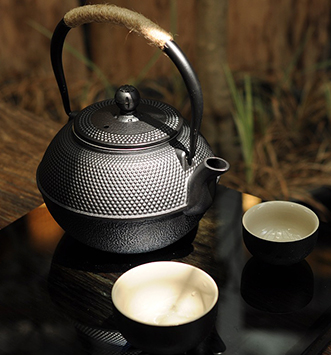
Tea lovers will tell you: the selection of the teapot is important in the preparation of tea. It has become a real ritual in some countries, as it is the case in Japan. The cast iron teapot is the symbol of this tea ceremony, also called Cha No Yu. Why choose a cast iron teapot? Let's take a look.
The history of the cast iron teapot
The cast iron teapot is, contrary to appearances, born in China in the 4th century AD and was not initially used for tea preparation. It was the Japanese who developed its manufacture and use. Cast iron teapots have become valuable objects for the ritual of tea preparation.
The cast iron teapot: originally a kettle
The cast iron teapot is not enamelled on the inside and is only used as a kettle. Also called Tetsubin, the cast iron kettle does not allow the infusion of tea. The Tetsubin is only used to boil water for the Japanese tea ceremony. Originally, the black cast iron teapot is made in small quantities by craftsmen and the Japanese cast iron Iwachu teapot is the most famous.
A product that has adapted to the European and Western market
The cast iron teapot has developed all over the world. Their design has changed and the color is no longer limited to simple black, as you can find a red cast iron teapot, or a blue Japanese cast iron teapot, for example. Now, the cast iron teapot with enamel inside for brewing tea is more common.
The different models of cast iron teapot
The Iwachu black cast iron teapot has traditionally had its own distinctive patterns. The Arare dot is the most common, it is a pattern of dots in relief more or less large on the whole teapot. You can also have lines or details that represent the fauna and flora of Japan. The capacity of the Japanese cast iron teapot is also variable. You can choose a small cast iron teapot for one teacup or a model with a larger capacity for several cups of tea.
You can choose the unglazed kettle to heat the water for tea preparation directly in your cup. You won't get a metallic taste, but the iron in the teapot will seep into the boiling water, which changes its taste and gives the teas sweeter and less bitter flavors. The enameled cast iron teapot can contain a removable filter or infuser usually made of stainless steel. Any tea such as Japanese green tea, white tea, red tea, sakura, etc. can be prepared in these teapots.
Advantages of the Japanese cast iron teapot
Choosing a Japanese cast iron teapot means taking the time to prepare your tea according to your desires. After brewing and tasting the tea, you will have to wash the teapot by hand and leave the lid open to dry. Avoid the dishwasher. Preparing tea with a cast iron teapot has its advantages!
A durable decorative item
Choosing a cast iron teapot is also choosing a decorative object that will last over time. Cast iron teapots are resistant to wear and tear, however the material is porous and the teapot can crack. For tea lovers, it is the ideal gift.
A heat resistant product
Cast iron has the ability to retain and distribute heat even better than a glass or ceramic teapot.